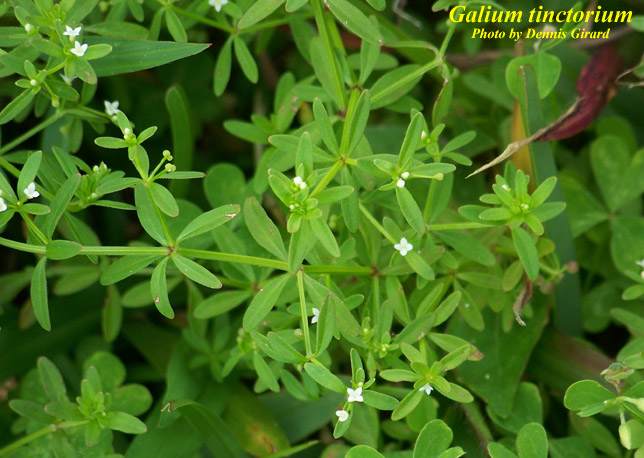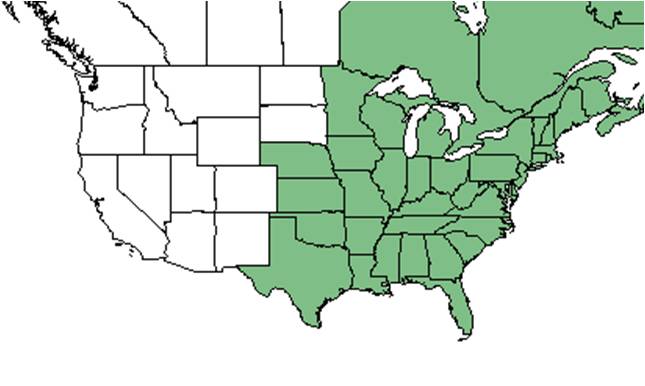Galium tinctorium
| Galium tinctorium | |
|---|---|

| |
| Photo by Dennis Girard, Atlas of Florida Vascular Plants | |
| Scientific classification | |
| Kingdom: | Plantae |
| Division: | Magnoliophyta - Flowering plants |
| Class: | Magnoliopsida - Dicotyledons |
| Order: | Rubiales |
| Family: | Rubiaceae |
| Genus: | Galium |
| Species: | G. tinctorium |
| Binomial name | |
| Galium tinctorium (L.) Scop. | |

| |
| Natural range of Galium tinctorium from USDA NRCS Plants Database. | |
Common name: Stiff marsh bedstraw; southern three-lobed bedstraw
Contents
Taxonomic notes
Synonyms: Galium obtusum var. floridanum (Wiegand) Fernald; G. claytonii Michaux; G. tinctorium ssp. floridanum (Wiegand) Puff.[1]
Varieties: Galium tinctorim L. var floridanum Wiegand; Galium tinctorium L. var. tinctorium.[1]
Description
A perennial plant with 5-6 whorled dark green leaves per node along the stem.[2] Roots are fibrous and rhizomatous. Flowers are radially symmetrical and are in clusters of three arising from leaf axiles and at the end of branching stems.[3]
Generally, Galium genus are "perennial or annual herbs, the stems weak, often scabrous; the roots often red or orange. Leaves whorled, entire. Flowers in simple or profusely branched cymes or the inflorescence reduced and the flowers 1-several and axillary; sepals usually obsolete, corolla rotate, 3-5 lobed; stamens 3-5. Fruit dry or sometimes fleshy, indehiscent, subglobose or reniform, or if the two carpels both develop and stay together the fruit broader than long."[4]
Specifically, for this species, G. tinctorium is an "annual (?), stems lax, spreading or reclining, simple or weakly branched, 2-5 dm long, minutely scaberulous, glabrous. Leaves usually 5-6 per node, rarely 4, linear to narrowly oblanceolate, 5-12 mm long, 1-2 mm wide or rarely more, rounded, glabrous. Corolla 3-lobed, white. Fruit dry, black, smooth subglobose, ca. 1.5 mm in diam. "[4]
Distribution
Generally, G. tinctorium is distributed across the eastern United States and Canada from Texas, Kansas, and Nebraska east to Minnesota, Florida, Ontario, and Nova Scotia. It is also native to the islands St. Pierre and Miquelon south of Canadian Newfoundland.[5] G. tinctorium var. floridanum is distributed from Massachusetts south to Florida and west to eastern Texas mostly along the southeastern coastal plain as well as inland to western Virginia, western North Carolina, southeastern Kentucky, southern Illinois, and southeastern Missouri. As well, G. tinctorium var. tinctorium can be found from the Canadian province Newfoundland west to Minnesota and Nebraska south to South Carolina, northern Georgia, Kentucky, and northeastern Missouri.[6]
Ecology
Habitat
This species is mostly found in marshes, ditches, and swamps.[6] In the Coastal Plain in Florida and Georgia, G. tinctorium has been found in cabbage palm hammocks, boggy depressions in coastal hammocks, bordering lakes, wet pine flatwoods, cypress swamps, river banks, Nyssa bottomlands, longleaf pine/saw palmetto flatwoods, sweetbay swamps, and bordering salt marshes. It can also occur in human disturbed areas such as roadside ditches, gas pipeline corridors, shores of drainage canals, and roadside seepage zones. Soil types include sandy loam, loamy clay, and clayey sand.[7] Throughout most of its distribution, G. tincotrium is listed by the USDA Natural Resources Conservation Service as an obligate wetland species that is almost exclusively found in wetland habitats.[5]
Associated species include Lilaeopsis carolinensis, Typha latifolia, Hydrocotyle umbellata, Fraxinus, Liquidambar, Acer, Gleditsia, Nyssa, Ulmus, and Carpinus.[7]
Phenology
G. tinctorium generally flowers from April until June.[6] It has been observed to flower March through June and fruit April through August.[8][7] Flowers are hermaphroditic.[9] Fruits are a pair of tiny, smooth round pods, each containing a seed.[3]
Seed bank and germination
A study in Bainbridge, Georgia did not find G. tinctorium to be present in the seed bank even when it was a component of the herbaceous vegetation.[10]
Pollination
Galium tinctorium has been observed at the Archbold Biological Station to host wasps from the Vespidae family such as Leptochilus alcolhuus.[11]
Conservation, cultivation, and restoration
Cultural use
Historically, Native Americans have used G. tinctorium for natural red dye, using it for feathers, porcupine quills, leather, and other uses.[12] It was also proposed medicinally to be useful for skin diseases since the plant can coagulate milk.[13]
Photo Gallery
References and notes
- ↑ 1.0 1.1 Weakley, A.S. 2015. Flora of the southern and mid-atlantic states. Working Draft of 21 May 2015. University of North Carolina at Chapel Hill, Chapel Hill, North Carolina.
- ↑ [Go Botany]Accessed: December 11, 2015
- ↑ 3.0 3.1 [[1]]Accessed: December 11, 2015
- ↑ 4.0 4.1 Radford, Albert E., Harry E. Ahles, and C. Ritchie Bell. Manual of the Vascular Flora of the Carolinas. 1964, 1968. The University of North Carolina Press. 984-7. Print.
- ↑ 5.0 5.1 USDA, NRCS. (2016). The PLANTS Database (http://plants.usda.gov, 15 May 2019). National Plant Data Team, Greensboro, NC 27401-4901 USA.
- ↑ 6.0 6.1 6.2 Weakley, A. S. (2015). Flora of the Southern and Mid-Atlantic States. Chapel Hill, NC, University of North Carolina Herbarium.
- ↑ 7.0 7.1 7.2 Florida State University Robert K. Godfrey Herbarium database. URL: http://herbarium.bio.fsu.edu. Last accessed: October 2015. Collectors: : Loran C. Anderson, George R. Cooley, M.W. Cullen,R. J. Eaton, J.P. Gillespie, R.K. Godfrey, Richard D. Houk, J.M. Kane, R. Kral, R.B. Ledin, Robert J. Lemaire, S.W. Leonard, William Lindsey, Sidney McDaniel, R.C. Phillips, James D. Ray, P.L. Redfearn , Grady Reinert, Paul O. Schallert, Cecil R. Slaughter, John K. Small, E. Smith, J.N. Triplett Jr., C.E. Wood. States and Counties: Florida: Alachua, Brevard, Citrus, Clay, Collier, Columbia, DeSoto, Flagler, Franklin, Gadsden, Gulf, Hamilton, Highland, Hillsborough, Holmes, Indian River, Jefferson, Leon, Levy, Liberty, Marion, Martin, Nassau, Orange, Polk, Putnam, Santa Rosa, Seminole, St. Johns, Union, Wakulla, Washington. Georgia: Thomas. Compiled by Tall Timbers Research Station and Land Conservancy.
- ↑ Nelson, G. PanFlora: Plant data for the eastern United States with emphasis on the Southeastern Coastal Plains, Florida, and the Florida Panhandle. www.gilnelson.com/PanFlora/ Accessed: 9 DEC 2016
- ↑ [[2]] Accessed: December 11, 2015
- ↑ Andreu, M. G., et al. (2009). "Can managers bank on seed banks when restoring Pinus taeda L. plantations in Southwest Georgia?" Restoration Ecology 17: 586-596.
- ↑ Deyrup, M.A. and N.D. 2015. Database of observations of Hymenoptera visitations to flowers of plants on Archbold Biological Station, Florida, USA.
- ↑ Porcher, F. P. (1869). Resources of the southern fields and forests, medical, economical, and agricultural. Richmond, VA, Order of the Surgeon-General.
- ↑ Rafinesque, C. S. (1828). Medical flora; or Manual of the medical botany of the United States of North America.